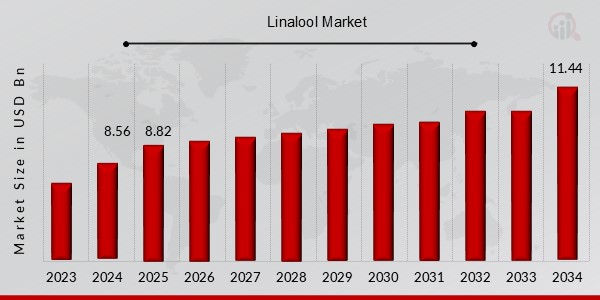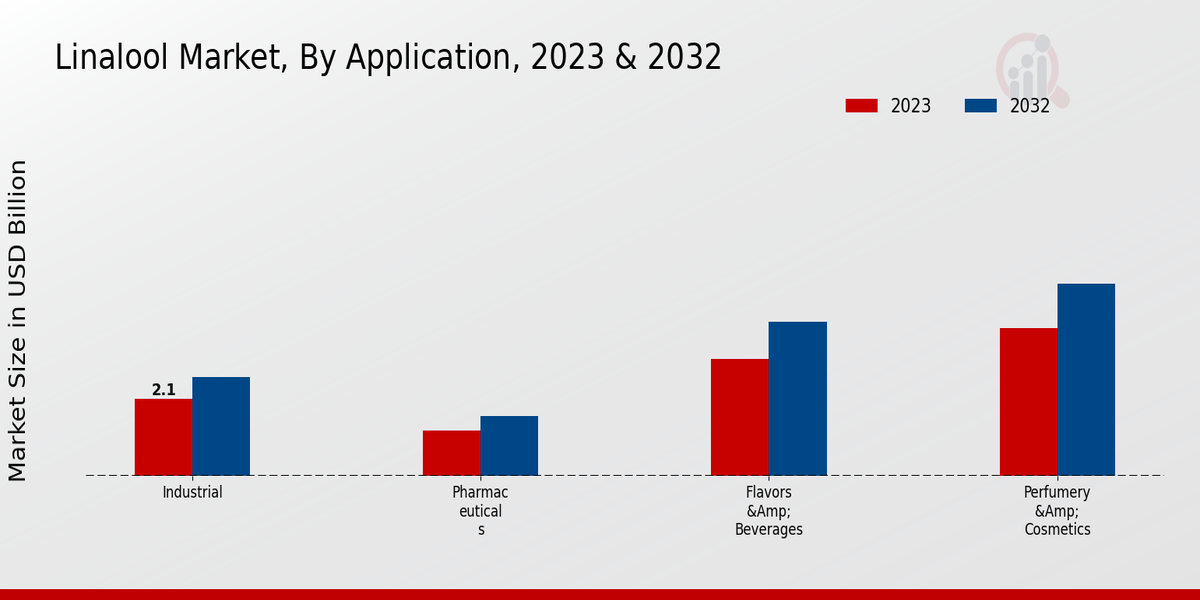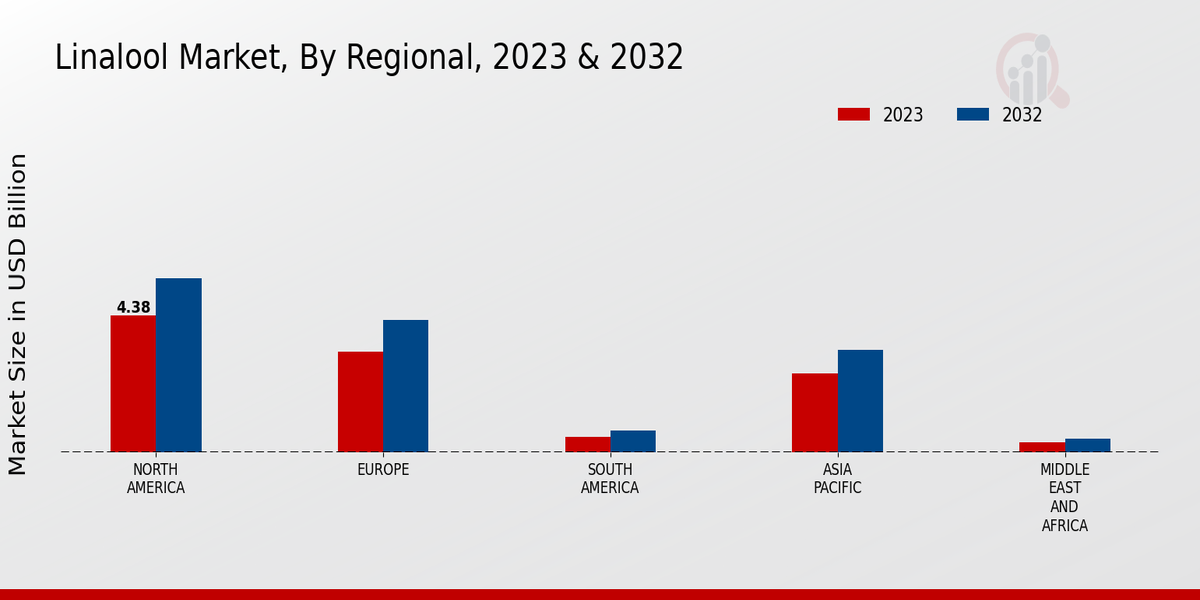Global Linalool Market Overview
Linalool Market Size was estimated at 8.56 (USD Billion) in 2024. The Linalool Industry is expected to grow from 8.82(USD Billion) in 2025 to 11.44 (USD Billion) by 2034. The Linalool Market CAGR (growth rate) is expected to be around 2.9% during the forecast period (2025 - 2034).
Key Linalool Market Trends Highlighted
The Linalool market is anticipated to witness a significant rise in the coming years. Key market drivers include growing demand for natural and organic fragrances, increasing awareness of the benefits of aromatherapy, and expanding use in personal care and cosmetic products. Opportunities exist in the exploration of new applications in various industries, such as pharmaceuticals and food flavorings. Recent trends indicate a shift towards sustainable and eco-friendly products, presenting opportunities for Linalool derived from renewable sources. Additionally, technological advancements in extraction and purification methods are expected to enhance the quality and efficiency of Linalool production. The market remains competitive, with key players focusing on innovation, product differentiation, and strategic partnerships to gain a competitive edge.

Source Primary Research, Secondary Research, MRFR Database and Analyst Review
Linalool Market Drivers
Growing Demand for Natural and Organic Personal Care Products
The increasing consumer awareness regarding the ill effects of synthetic chemicals in personal care products on health has also increased the usage of natural and organic personal care products, including linalool. Linalool is a naturally occurring terpene alcohol and is gaining importance as a major ingredient in various personal care products, including skincare, haircare, and cosmetics. Owing to its antibacterial, antifungal, and anti-inflammatory properties, these are the best products used for sensitive scalp and skin. As a result, the market of linalool is expected to grow over the forecast period.
Expansion of the Flavor and Fragrance Industry
Linalool's distinct floral and citrusy aroma makes it a highly sought-after ingredient in the flavor and fragrance industry. It is widely used in the creation of perfumes, colognes, and other scented products. The growing demand for fragrances and flavors in various applications, including personal care, household products, and food and beverages, is expected to boost the demand for linalool in the coming years.
Increasing Applications in Pharmaceuticals and Therapeutics
Linalool presents a number of pharmacological properties, including analgesic, anticonvulsant, and anxiolytic effects. The growing interest in the development of pharmaceuticals and therapeutic agents based on linalool will also provide the ground for the expansion of its applications in the pharmaceutical industry in the near future. Ongoing research will help to realize its potential in the treatment of pain, epilepsy, and anxiety disorders, among others.
Linalool Market Segment Insights
Linalool Market Application Insights
Application Segment Insights and Overview The linalool market is segmented by application into perfumery cosmetics, flavors beverages, pharmaceuticals, and industrial. The perfumery cosmetics segment holds the largest market share and is expected to generate over 40% of revenue in 2023. The segment grows because consumers become aware of specific natural and organic perfumes and cosmetic products. The flavors beverages segment is the second application in the products and generates a market share of over 30%. Linalool is mainly used in the flavors and fragrance industry because of its sweet, floral aroma.
In the food and beverages industry, the compound is mainly present in citrus-flavor beverages, baked goods, and confectionery products. The pharmaceutical segment will grow at a steady rate of over 15% in the market share. Linalool compound provides anti-inflammatory, antimicrobial, and anxiolytic properties, making it a candidate for various therapeutic applications. The industrial segment is the lowest in the market share and is expected to provide over 10% of the revenue in 2023. The application of the linalool compound in the industrial segment majorly produces soaps, detergents, and cleaning products.The growth of the linalool market is expected to grow steadily, as evidenced by the increased demand in the perfumery cosmetics, flavors, beverages, and pharmaceutical markets. Also, with increasing preferences by consumers, the growth of the market will be rapid in the long run.
Source Primary Research, Secondary Research, MRFR Database and Analyst Review
Linalool Market Purity Insights
The Linalool Market segmentation by Purity is expected to show substantial growth in the coming years. The '90-95%' purity segment held the largest market share in 2023, and it is expected to continue its dominance throughout the forecast period. This segment is primarily driven by the high demand for linalool in the flavor and fragrance industries, where cost-effectiveness is a key factor. The '95-98%' purity segment is also expected to witness significant growth due to its increasing use in personal care and cosmetic applications. The '98-99%' and '99% and above' purity segments are expected to grow at a steady pace, driven by the demand for high-quality linalools in the pharmaceutical and food industries.
Linalool Market Extraction Method Insights
The Linalool Market segmentation by Extraction Method is broadly categorized into Steam Distillation, Solvent Extraction, and Supercritical Fluid Extraction. Among these, Steam Distillation dominates the Linalool Market revenue, accounting for a significant share. The widespread adoption of steam distillation is attributed to its cost-effectiveness, simplicity, and ability to extract linalool with high purity. Solvent Extraction holds the second-largest share in the market owing to its efficiency in extracting linalool from various plant materials.
However, concerns regarding the use of solvents and their potential environmental impact are driving the exploration of alternative extraction techniques. Supercritical Fluid Extraction, which utilizes supercritical fluids like carbon dioxide, is gaining traction due to its ability to extract linalool without the use of solvents, offering a greener and more sustainable extraction method. The Linalool Market data indicates a growing demand for linalool extracted through sustainable and eco-friendly methods, which is expected to drive the growth of the Supercritical Fluid Extraction segment in the coming years.
Linalool Market Source Insights
The Linalool Market segmentation by Source includes Linaloe Wood, Lavandin, Lavender, and Bergamot. Linaloe Wood is a key source of linalool, and it is expected to witness significant growth in the coming years due to its increasing demand in the fragrance industry. Lavandin is another important source of linalool, and it is widely used in the production of essential oils and personal care products. Lavender is also a valuable source of linalool, and it is primarily used in the manufacturing of cosmetics and pharmaceuticals. Bergamot is another source of linalool, and it is mainly utilized in the production of perfumes and flavorings.
Linalool Market Regional Insights
The Linalool Market is segmented into North America, Europe, APAC, South America, and MEA. Among these regions, North America is expected to hold the largest market share in 2023, owing to the growing demand for linalool in the region's personal care and cosmetics industries. Europe is expected to follow North America in terms of market size, driven by the region's strong presence in the fragrance industry. APAC is expected to witness the fastest growth in the coming years, owing to rising disposable incomes and increasing consumer awareness of natural ingredients in the region. South America and MEA are expected to account for a smaller share of the Linalool Market in 2023, but these regions are expected to witness steady growth in the coming years.
Source Primary Research, Secondary Research, MRFR Database and Analyst Review
Linalool Market Key Players And Competitive Insights
The key players operating in the Linalool Market continue to offer new and innovative products to cater to the fast-changing preferences of the customers. The Linalool Market covers a highly fragmented scope, with a multitude of prominent companies consistently dominating the market. Some of the prime competitors providing various linalool solutions across different industries include BASF SE, Symrise AG, Firmenich SA, International Flavors Fragrances Inc., and Givaudan SA, among others. These leading suppliers of the Linalool Market adhere to a robust product and service model, with a strong focus on quality products to address the concerns and requirements of the target clientele.
Furthermore, these market players invest heavily in the development and production of new technologies and methodologies, making the Linalool Market even more competitive. The key competitors of the Linalool Market will continue to offer new products and solutions as a means to solidify their standing in the market. Subsequently, the use of linalool among new and potential players will also increase, a scenario that heightens the level of competition in the linalool supply market moving forward.
A Leading firm in the Linalool Market is Symrise AG. The company’s headquarters is situated in Germany, and it operates across the globe. The company is a well-known supplier of a wide range of linalool products and services in various markets, including foods and beverages, cosmetics, and pharmaceuticals. It focuses on delivering value-added solutions, with an emphasis on research and innovation as a means to improve the quality of customer service. Currently, Symrise AG owns a strong presence in the Linalool Market, as evidenced by its unyielding commitment to promoting high-quality products and services.
Key Companies in the Linalool Market Include
- Mane SA
- BASF
- Symrise AG
- International Flavors Fragrances Inc. (IFF)
- Bedoukian Research, Inc.
- Takasago International Corporation
- Croda International
- Haining Baichuan Chemical Co., Ltd.
- Hangzhou Dayangchem Co. Ltd.
- Penta Manufacturing Company
- Givaudan
- TCI Chemicals (India) Pvt. Ltd.
- Firmenich SA
- The Chemistry Factory
- Loba Chemie GmbH
Linalool Market Industry Developments
The linalool market is projected to reach USD 10.5 billion by 2032, exhibiting a CAGR of 2.94% during the forecast period. Rising demand for linalool in the fragrance and flavor industries, coupled with its increasing use in personal care and aromatherapy products, is driving market growth. The growing popularity of natural and organic ingredients is also contributing to the market's expansion.Recent news developments in the linalool market include the launch of new linalool-based products by leading fragrance and flavor companies. For instance, in 2023, Firmenich, a leading fragrance and flavor company, announced the launch of a new linalool-based fragrance ingredient called "Linalyl Acetate Natural." This ingredient is derived from renewable plant sources and offers a fresh, floral scent with a long-lasting effect. Such innovations are expected to further drive the growth of the linalool market in the coming years.
Linalool Market Segmentation Insights
Linalool Market Application Outlook
- Perfumery Cosmetics
- Flavors Beverages
- Pharmaceuticals
- Industrial
Linalool Market Purity Outlook
- 90-95%
- 95-98%
- 98-99%
- 99% and above
Linalool Market Extraction Method Outlook
- Steam Distillation
- Solvent Extraction
- Supercritical Fluid Extraction
Linalool Market Source Outlook
- Linaloe Wood
- Lavandin
- Lavender
- Bergamot
Linalool Market Regional Outlook
- North America
- Europe
- South America
- Asia Pacific
- Middle East and Africa
Linalool Market Report Scope
| Report Attribute/Metric |
Details |
| Market Size 2024 |
8.56(USD Billion) |
| Market Size 2025 |
8.82(USD Billion) |
| Market Size 2034 |
11.44(USD Billion) |
| Compound Annual Growth Rate (CAGR) |
2.94% (2025 - 2034) |
| Report Coverage |
Revenue Forecast, Competitive Landscape, Growth Factors, and Trends |
| Base Year |
2024 |
| Market Forecast Period |
2025 - 2034 |
| Historical Data |
2020 - 2024 |
| Market Forecast Units |
USD Billion |
| Key Companies Profiled |
Mane SA, BASF, Symrise AG, International Flavors Fragrances Inc. (IFF), Bedoukian Research, Inc., Takasago International Corporation, Croda International, Haining Baichuan Chemical Co., Ltd., Hangzhou Dayangchem Co. Ltd., Penta Manufacturing Company, Givaudan, TCI Chemicals (India) Pvt. Ltd., Firmenich SA, The Chemistry Factory, Loba Chemie GmbH |
| Segments Covered |
Application, Purity, Extraction Method, Source, Regional |
| Key Market Opportunities |
Growing demand for personal care products Increasing applications in the food and beverage industry Rising awareness of aromatherapy Expanding consumer base for natural and organic products Technological advancements in extraction and purification methods. |
| Key Market Dynamics |
Increasing consumer demand for natural fragrances Growing popularity of aromatherapy Rising awareness of therapeutic benefits Expansion of personal care and cosmetics industry Technological advancements in extraction and production techniques |
| Countries Covered |
North America, Europe, APAC, South America, MEA |
Frequently Asked Questions (FAQ) :
The Linalool market is expected to reach a valuation of 11.44 Billion USD by 2034.
The Linalool market is projected to grow at a CAGR of 2.9% from 2025 to 2034.
North America is expected to account for the largest share of the Linalool market by 2032.
Linalool finds applications in fragrances, flavors, cosmetics, and pharmaceuticals.
Key players in the Linalool market include Firmenich, Givaudan, Symrise, and Takasago.
Rising demand for natural fragrances and flavors, increasing use in personal care products, and growing awareness of the therapeutic benefits of Linalool are driving market growth.
Market challenges include fluctuations in raw material prices, stringent regulations, and competition from synthetic fragrances.
Opportunities for growth include the development of new applications, expansion into emerging markets, and collaborations between manufacturers and end-users.
Key trends shaping the market include the increasing adoption of sustainable practices, the growing popularity of aromatherapy, and the rising demand for natural and organic products.
The market is expected to witness steady growth in the coming years, driven by increasing consumer demand and technological advancements.
















